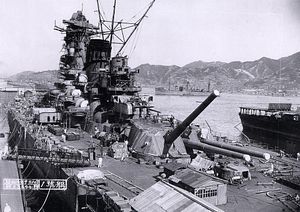Paul Allen, founder of Microsoft, appears now to have found the wreck of HIJMS Musashi. To claim that Musashi was the most powerful battleship ever built would court needless controversy, but she was by most accounts the largest (very marginally larger than her sister, HIJMS Yamato). The sinking of HIJMS Musashi in October 1944 made depressingly clear what many observers had suspected since 1941, and even as early as the 1920s: sufficient numbers of committed carrier aircraft could sink a battleship, even when that battleship carried a heavy anti-aircraft armament and could maneuver at speed. But a more careful look at the story offers some insights into how we understand the relationship between military innovation and “obsolescence.”
In one telling, the sinking of Musashi was the final answer to the challenge that Billy Mitchell made to the utility of warships in the early 1920s. American level bombers sank the hulk German battleship Ostfriesland in July 1921, leading airpower advocates to claim that the battleship, and really all naval vessels, had become “obsolete.” Taranto and Pearl Harbor, where carrier aircraft sank battleships at anchor, were part of this story, but an even more important milestone was the sinking of HMS Repulse and HMS Prince of Wales, under steam, by Japanese aircraft on December 10, 1941.
Another telling offers more complexity. Musashi reportedly took 19 torpedoes and 17 bombs (in comparison, the eight battleships under attack at Pearl Harbor on December 7, 1941 took 15 torpedoes and 19 bombs collectively) before sinking into the Sibuyan Sea. No air force in the world was capable of inflicting such damage on a moving, well-defended target before mid-1944, when the U.S. Navy accumulated a fleet of pilots, attack aircraft, and carriers of a size and lethality that no one had envisioned in 1942, much less 1921.
Musashi entered service in August 1942, and remained in service for just over two years. Was she obsolete before completion (and perhaps even before being laid down)? In one sense, yes; simply in terms of maximizing lethality, the Imperial Japanese Navy (IJN) would have done better to concentrate its efforts on submarines and naval aviation. In hindsight, the construction of Musashi and her counterparts seems wasteful and stupid. But then aircraft carriers were considerably more vulnerable than battleships, even toward the end of the war. Damage that would have left a battleship still operational could cripple or destroy an aircraft carrier.
This narrative of obsolescence, commonly told of the battleship, serves to obscure more than it illuminates. It’s impossible to argue that Musashi represented a wise allocation of Japanese national resources. At the same time, tagging Musashi as “obsolete” leads to a misunderstanding of military utility. The navies of World War II found many uses for “obsolete” battleships, some intended by their designers, others not. The rapid eclipse of the battleship in the post-war era owed as much to the structure of international politics (and the destruction of the great navies of World War II) as it did to the obsolescence of the platform.
The strategic bomber offers a useful contrast/comparison. The B-52 Stratofortress is as obsolete for its intended mission as HIJMS Musashi would be for its, and new purpose-built aircraft will have virtually no resemblance to the old BUFF. But nobody gets to start from scratch, and the ability of a military to find uses for its legacy platforms is often as important as its ability to harness new technological innovations.
The final legacy of Musashi and the other great battleships that led navies is perhaps the belief that the only defense lays in not getting hit; no degree of armor or structural resilience could prevent the destruction of a surface ship by aircraft or submarine. This lesson was perhaps overlearned; the experience of British destroyers in the Falklands indicated that naval architects needed to pay some attention to resilience. Indeed, the next war may demonstrate that “stealth” fighters are every bit as “obsolete” as armored battleships.

































